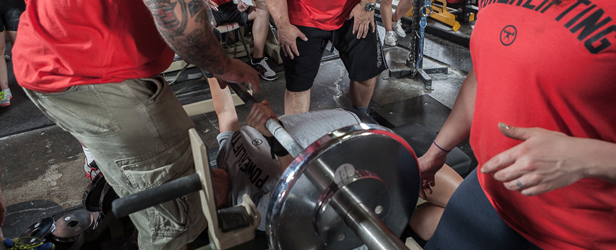
The key to benching big weights is knowing your exact setup and executing it the same way for every single attempt. Put your body in the maximum position and you will lift the maximum poundage. Shoulder placement, leg position, bar handling, leg drive, air, stroke, and even more leg drive are the keys to PRs.
Here is a bird’s eye view of a successful bench setup. For reference, this video is of a 315-pound bench, which is 60 percent of my meet best 525 pounds.
You can see the exact steps I go through in order to get my bench setup exactly how I want it. Every step is important and can improve anyone’s bench if done consistently.
Here is an example of bench setup steps to get you started:
1. Put your feet up and set your back.
By placing your feet on the bench and getting your back set where it belongs, you get your position on the bench in the exact spot you want it to be.
2. With your feet still on the bench, squeeze your shoulder blades together and get your weight on your traps.
A strong bench is a short bench, and by getting your shoulders together and down, you will shorten your stroke and put your shoulders in a position to tuck your elbows safely. This isn’t only the most efficient way to bench, but also the safest.
3. Get your belt out of the way.
Your belt needs to be on for support, but pushed low to maximize your arch. Either push your belt down yourself or having a training partner do it for you once you’re set up. This will shorten your stroke and give your stomach room for air.
4. Take your time with grip.
Your connection to the bar is the most vital part of this lift. Get the bar in the meat of your hands so that it is directly over your forearms. If the bar is too high in your hand, your wrist will bend back and add an unneeded lever system to your bench.
5. Set your feet.
Your feet need to be perfect or you’ll risk losing leg drove or worse, getting red lighted for your butt coming off the bend. You need to pull your feet back and underneath you to maximize your arch while keeping your butt on the bench. Test your feet and arch several times to get the feet the furthest back and the arch as high as possible. Don’t rush this. Tweak as much as you need to, and wiggle your feet until you feel like you’re about to pop. Once you feel that pressure, you’re ready to bench.
6. Start the unrack with leg drive.
Once the bar is in your hands, it needs to be moved toward your lower chest and sternum area without bending your arms. This will take some work, but you are able to sink the bar closer while keeping your arms straight. By pushing through your legs on the unrack and getting the bar as close to your body as possible before starting the lift, you’ll be in a strong position to hold the weight until you get a start command.
7. Bring the bar over your chest and lower to your touch spot.
Move the bar to the spot on your lower chest that allows you to utilizes your lats and upper back. This will help make your descent shorter and let you use your pecs, delts, and triceps together.
8. Take a big breath and fill your stomach with air before you bend your arms.
The bar needs to go down in an arc toward your touch spot. The elbows should be around 45 degrees. Focus on bringing your body up to meet the bar.
9. Touch, pause, and initiate with forward movement.
I recommend a press that starts with a backward phase before moving into an arc over the face. Most people don’t have strong enough triceps to push the bar in a straight light. Don’t fight it. Go with it and let your delts, pecs, and lats move the bar.
10. Lockout!
As the bar is moving back to lockout, now is the time to let it drift over your face. The triceps will kick in here, where they are strongest. Letting the bar drift away from your torso lets the pecs and delts take a break while the triceps finish the movement.
Go through these simple steps to remember the ten rules of benching:
- Feet up and belt down.
- Shoulder blades back.
- Set grip.
- Set feet.
- Unrack the back and start leg drive.
- Place bar over touch spot.
- Touch at high point of sternum.
- Press back first, then arc.
- Drift bar towards face for lockout.
To demonstrate these techniques, I have included a video of my third bench at an RPS meet I did this year. I benched 480, 515, and 525 after squatting 700 pounds in only a belt. As you can see, I put all of these bench techniques into my setup and hit a 15-pound PR as a result.
Implementing one or two of these steps will have a positive impact on your bench. Implementing them all will have a lasting impact that leads to huge numbers.











1 Comment